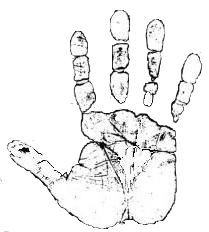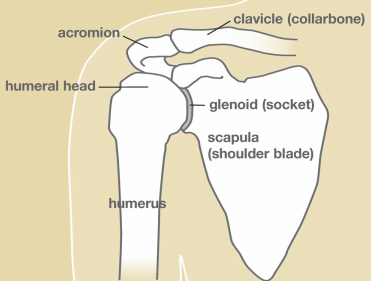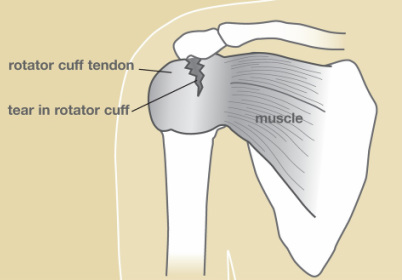MAKE AN APPOINTMENT TODAY!
Rotator Cuff Tear
The rotator cuff is the confluence of the tendons of four muscles that encompass the ball joint (humeral head) of the shoulder (see Figures 1, 2). The muscles originate on the shoulder blade (scapula) and attach on the arm bone (humerus). The rotator cuff has two functions. It provides stability to the shallow shoulder (glenohumeral) joint. Its second
|
function is to provide motors (muscles) to move the shoulder. As time passes and we age, so does the rotator cuff. The rotator cuff tendon degenerates with age. It may also undergo wear and tear as it rubs between the acromion (tip of the shoulder blade) and the humeral head. It may become thickened and inflamed, which may be described as impingement syndrome. Change can vary from microscopic tears and bursitis to a large rotator cuff tear. The symptoms include pain, weakness, restricted motion, a feeling of instability, catching, and locking. Rotator cuff pathology is really a continuum or a spectrum of abnormalities ranging from a normal, asymptomatic aging process to endstage arthritis and instability caused by absence of the rotator cuff.
|
Rotator Cuff Symptoms
Everyone over 50 years of age has abnormalities in his or her rotator cuff and potentially a small rotator cuff tear. Therefore, everyone has some degree of rotator cuff pathology as he or she ages. How this pathology is manifest varies widely. Most people are not symptomatic. Onset of symptoms can be related to ordinary activities of daily living, or they can be attributed to a single event. The symptoms mentioned above are usually aggravated in certain positions, such as reaching back, for example, to fasten a seat belt or pick up a briefcase out of the back seat. Rotator cuff symptoms are worse when the arm is elevated overhead, higher than the shoulder, especially if the elevated arm is loaded, for example, picking up a stack of plates out of a cupboard. Overhand activities (pitching, throwing, tennis, or racquetball) commonly accentuate symptoms.
Rotator Cuff Tear Diagnosis
History and physical examination are the initial evaluation that leads to diagnosis of rotator cuff pathology. Pain can be provoked by overhead maneuvers, and there may be weakness of the shoulder muscles. Plain x-rays are done to check for calcifications, arthritis, or bone problems. MRI may help to assess the tendons for inflammation and tears. Steroid injections and arthroscopy may be used as diagnostic and therapeutic tools.
Rotator Cuff TreatmentAlterations in activities and learning to use the shoulder in a safer, more comfortable manner is important. Anti-inflammatory medications are used. Physical therapy may help improve mobility and strengthen shoulder muscles. Steroid injections are used for pain relief and their anti-inflammatory effect. Surgical intervention is usually the last option. Surgical options vary widely. Arthroscopy with limited incisions or open surgery can be done to remove inflamed bursa and impinging bone spurs, decompressing or opening up the space available for the rotator cuff (see Figure 3). The end of the clavicle (collarbone) may be removed if it has impinging spurs. Some rotator cuff tears can be repaired with arthroscopic techniques. Other tears require a larger incision and surgical exposure. Some large tears, particularly those associated with resultant arthritis, simply cannot be repaired. Arthritis that occurs as a result of rotator cuff deficiency has specific characteristics and presents extraordinary challenges. When the deformity, pain, and dysfunction from the arthritis become disabling,
|
Rotator Cuff Rehabilitation
Postoperative treatment depends on the operation done, but therapy is a critical part of the recovery, which can take from three to twelve months. A coordinated effort between the patient, surgeon, and physical or occupational therapist is required.
Reproduced with permission from the American Society for Surgery of the Hand www.handcare.org
Disclaimer and Privacy
IZADIHAND.COM © 2011-2022 Kayvon David Izadi MD - All Rights Reserved
Webmaster
IZADIHAND.COM © 2011-2022 Kayvon David Izadi MD - All Rights Reserved
Webmaster



